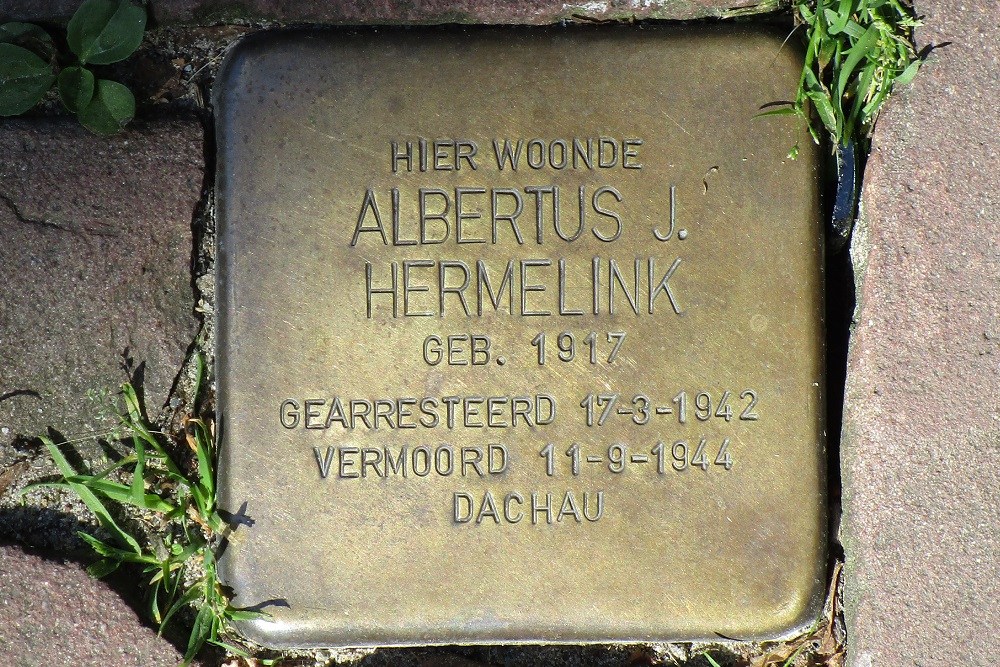Stumbling Stone Grotestraat 157
This brass memorial plaque (Stolperstein or stumbling stone) commemorates:
* ALBERTUS J. HERMELINK (born 1917, arrested 17-3-1942, murdered 11-9-1944, Dachau)
Albert was born on October 28, 1917 in 's-Hertogenbosch and lives in Almelo. As part of the general mobilization of 1939, Albert is called up for military service and assigned to the field artillery as adjutant non-commissioned officer. In the May days of 1940 he fought in Zeeland, among other places. After his demobilization, Albert starts working as a merchant in his hometown of Almelo. When an English pilot crashes nearby in the spring of 1942, Albert helps him on his way by showing him the way and guiding him a long way. The German authorities find out about this and arrest Albert on March 17. He is detained in the so-called 'Oranjehotel', the prison in Scheveningen, to be transferred in July 1942 to the prisoner of war prison in Utrecht on the Gansstraat. There he appears until the autumn of 1942, when he is taken to Amsterdam where he hears his trial. Subsequently, he was held for a year in the prison on Wolvenplein in Utrecht, until October 1943. From there he was taken to the German camps via camp Amersfoort with a transport of 'political prisoners'. Albert has been given the status of Nacht und Nebel prisoner, which means that he must disappear without a trace in the camps, without the next of kin knowing whether he died or not. He ends up in the Nacht und Nebel camp Natzweiler-Struthof, high in the Vosges. The camp is located in Alsace-Lorraine, which was then re-incorporated into Germany, the bilingual border area that has been part of France since 1945. The prisoners perform extremely hard work in the quarries for days with the aim of working them to death. Food and medicines are therefore hardly sufficient and the prisoners are exposed to all kinds of severe abuse. Due to the hardships, Albert contracted tuberculosis after a few months. A doctor in the camp makes an effort to hospitalize Albert and provide him with extra food, but the help offered is of no avail. At the beginning of September 1944, Natzweiler-Struthof is evacuated due to the arrival of the Americans; the prisoners are put on a transport to Dachau. The seriously ill Albert was also put on the train and died during transport, according to a fellow prisoner on the night of September 5 to 6 between Oppenheim and Frankfurt. His body will be forwarded to Dachau and cremated there. Albert turned 26 years old.
This Stolperstein is here for a resistance fighter, arrested, imprisoned and murdered in World War II.
"Stolpersteine” is an art project for Europe by Gunter Demnig to commemorate victims of National Socialism (Nazism). Stolpersteine (stumbling stones) are small, 10x10cm brass plaques placed in the sidewalk in front of the last voluntary residence of (usually Jewish) victims of the Nazis. Each plaque is provided with the victim’s, date of birth, and fate. By doing this, Gunter Demnig gives an individual memorial to each victim. One stone, one name, one person. He cites the Talmud: “A human being is forgotten only when his or her name is forgotten.”
Do you have more information about this location? Inform us!
Source
- Text: Dick de Bruijne + TracesOfWar
- Photos: Dick de Bruijne
- | Brabantsegesneuvelden.nl
Nearby
Museum
Point of interest
- V1 Launch Platform Nijreesbos Almelo - Almelo
- V1 Launching Site Tusveld Bornerbroek - Bornerbroek
- V1 Launching Site Bornebroeksestraat Borne - Borne
Monument
- Memorial Fallen Soldiers Dutch East Indies and New Guinea - Almelo
- War Memorial Almelo - Almelo
- Liberation Memorial Almelo - Almelo
Cemetery
- Jewish Graves Almelo - Almelo
- Commonwealth War Graves Municipal Cemetery 't Groenedael Almelo - Almelo
- Dutch War Graves Municipal Cemetery 't Groenedael Almelo - Almelo
Remembrance Stone
- Stumbling Stone Grotestraat 144 - Almelo
- Stumbling Stones Grotestraat 156 - Almelo
- Stumbling Stones Molenkampspark 2 - Almelo





